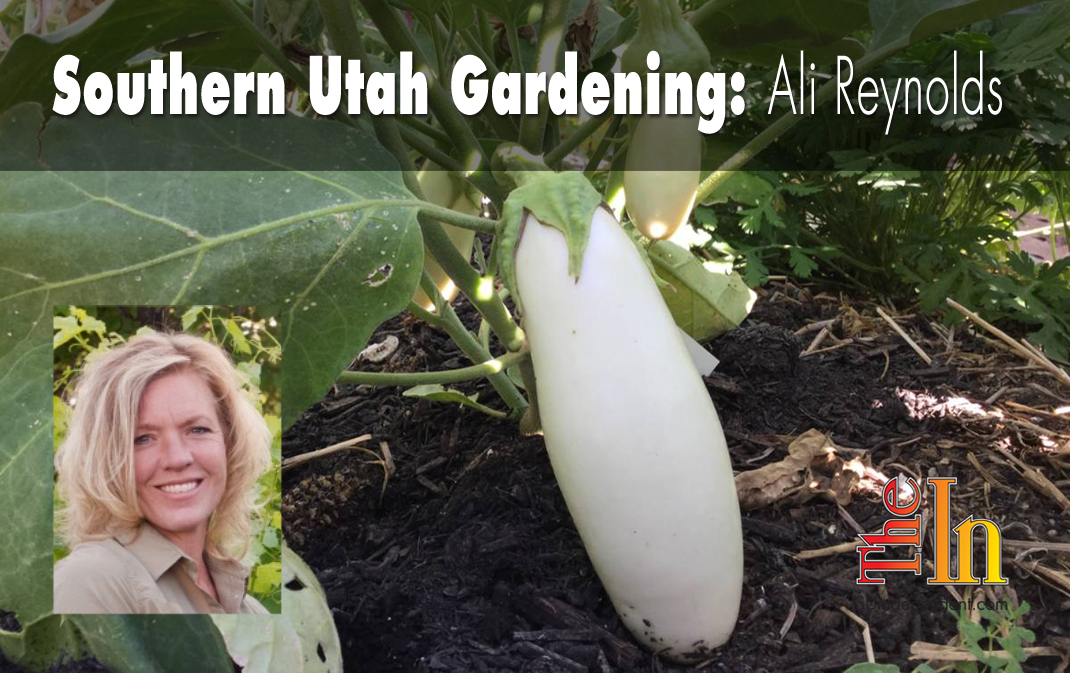
Southern Utah Gardening: Growing Eggplant Successfully
As much fun as it is to peruse the great variety of eggplants offered in seed catalogs and imagine all the delicious options for preparing them, it’s easy to lose sight of what comes in between: growing them. Eggplants can be a finicky crop, but if you can get them off to a good start, keep them warm, and keep pest damage to a minimum, an excellent harvest awaits you. Then the trouble you’ve taken to choose just the right eggplant for the dish of your dreams will pay off. My favorite eggplant dishes are caponata, baba ghanoush, grilled eggplant, marinated slices, and stir-fried. You see, I enjoy eggplant!
The variety of colors and shapes are stunning, each with it’s own flair and flavor. I love the striped purple-and-white varieties but enjoy growing all of them including Listada de Gandia, Thai Green, Violette Longue, Rosa Bianca, and — well, honestly all of them are my favorites.
Don’t buy your starts to early in the season. I see starts as early as February here in southern Utah, which is much too early. Even March or the first part of April is to early. Gardeners should wait until the soil has warmed, the days are consistently sunny, and all threat of frosty or cold nights has passed before buying. Patience will be rewarded. Eggplants do not like to be cold and will suffer from failure-to-thrive syndrome when conditions are not to their liking.
Always look for short and stocky plants that are not root bound; check the drainage hole to make sure the roots are not protruding. The plants should not have flowers or fruits already formed. If you feel the need to buy before the plants are sold out, make sure you transplant them into gallon containers to give the root systems room to develop. Place them outdoors during the day and indoors at night until the weather warms sufficiently.
When it’s time to set the plants out in the garden, I put the eggplants in fertile, well amended beds with good drainage. Add a good amount of a well balanced organic fertilizer such as a 4-4-4 vegetable fertilizer that is slow release. In our hot climate, young plants will need to be watered at least two times a week, depending on your soil’s composition. Eggplants do not like standing water, so mature plants should be watered deeply and infrequently. But do not allow the leaves to wilt during the day.
Once the plants are in the ground, I like to place two bamboo sticks on two sides of each eggplant. When doing this later, you risk damaging the root system. Tomato cages work well for eggplants as well.
Give eggplants a bit of shoulder room as they can grow 18 to 36 inches tall, depending on the variety you grow. Usually, the larger the fruit, the larger the plant.
Eggplants are very susceptible to flea beetles, which make pin holes in the leaves and can cause considerable damage. The plants can be covered with row covers early in the season to help prevent the first wave of flea beetles. Most healthy plants will recover from the leaf damage, but prevention or early detection will make for earlier harvests. The use of Neem spray during the evening will ward off these pests.
I feed my eggplants two or three times during the growing season with a light application of liquid organic fertilizer or compost tea. This helps to supply potassium, which the plants need to keep producing fruit.
If you have treated your crop well, you should have a bountiful harvest. I pick eggplants when they are bright and shiny. Dull-skinned fruits have begun to form mature seeds and tough skin. In our warm climate, eggplants tend to lose their shine before they reach their full maturity, so don’t hesitate to harvest them when they are small so you can enjoy firm, mild, seedless flesh.
I always grow a wide variety so that I have the right eggplant for the right dish.
The long, skinny Asian eggplants such as Pingtung and Thai green are perfect for stir frying. Rosita has a mild flavor, making a wonderful eggplant for marinated preserves. Listada de Gandia makes a great baked eggplant Parmesan. White, smooth-skinned eggplants are wonderful in Caponata.
Here’s simple eggplant recipe.
Sautéed Eggplant
—1 1/2 pounds eggplant
—4 tablespoons olive oil
—6 garlic cloves, sliced thinly
—Salt and freshly ground pepper
—Chopped, fresh flat-leaf parsley
Cut eggplant into sticks about 2 inches long and 3/4 inch wide. Heat 3 tablespoons of the oil in a large sauté pan over medium heat. Add the eggplant and sauté for about 10 minutes, stirring so it doesn’t stick. After 5 minutes, you can cover the pan so the moisture helps to keep it from sticking, or if necessary, add a little more oil. Add the garlic and cook for another 2–3 minutes. Season with salt and pepper and garnish with parsley. Serve hot.
Articles related to “Southern Utah Gardening: Growing Eggplant Successfully”



